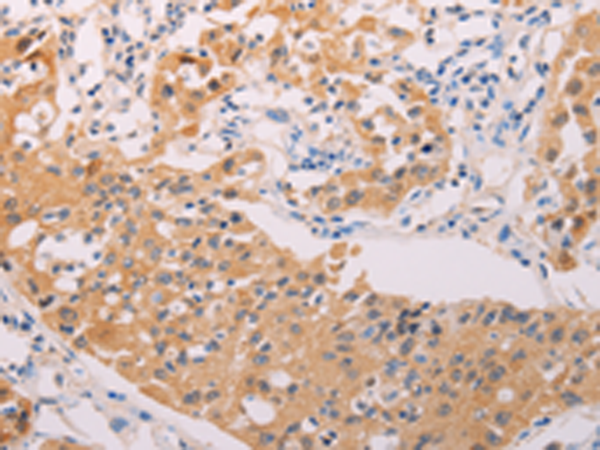

| WB | 咨询技术 | Human,Mouse,Rat |
| IF | 咨询技术 | Human,Mouse,Rat |
| IHC | 1/50-1/200 | Human,Mouse,Rat |
| ICC | 技术咨询 | Human,Mouse,Rat |
| FCM | 咨询技术 | Human,Mouse,Rat |
| Elisa | 1/2000-1/10000 | Human,Mouse,Rat |
| Aliases | HOT; ADH8; HMFT2263 |
| Host/Isotype | Rabbit IgG |
| Antibody Type | Primary antibody |
| Storage | Store at 4°C short term. Aliquot and store at -20°C long term. Avoid freeze/thaw cycles. |
| Species Reactivity | Human, Mouse, Rat |
| Immunogen | Synthetic peptide of human ADHFE1 |
| Formulation | Purified antibody in PBS with 0.05% sodium azide and 50% glycerol. |
+ +
以下是关于ADHFE1抗体的3篇参考文献(简要概括):
1. **文献名称**: "ADHFE1 is a breast cancer oncogene and induces metabolic reprogramming"
**作者**: Wang et al.
**摘要**: 该研究通过免疫组化(使用ADHFE1抗体)发现ADHFE1在乳腺癌中高表达,并促进肿瘤细胞的代谢重编程(如增强谷氨酰胺代谢),提示其作为潜在治疗靶点。
2. **文献名称**: "ADHFE1 modulates mitochondrial metabolism and supports tumor growth via 2HG production"
**作者**: Li et al.
**摘要**: 利用ADHFE1抗体进行Western blot和免疫荧光实验,证明ADHFE1通过催化α-酮戊二酸生成D-2-羟基戊二酸(2HG),影响表观遗传调控和线粒体功能,促进肿瘤生长。
3. **文献名称**: "ADHFE1 expression correlates with glioma malignancy and patient prognosis"
**作者**: Zhang et al.
**摘要**: 研究采用ADHFE1抗体对胶质瘤组织进行染色,发现ADHFE1表达与肿瘤恶性程度呈正相关,且高表达患者预后较差,可能通过调控缺氧信号通路发挥作用。
(注:若需具体文献来源或补充DOI/PMID,可进一步提供检索关键词或数据库筛选条件。)
ADHFE1 (Alcohol Dehydrogenase Iron-Containing 1), also known as hydroxyacyl-coenzyme A dehydrogenase homolog (HADH2), is a mitochondrial enzyme involved in metabolic pathways, particularly the oxidation of D-3-hydroxybutyrate and other short-chain hydroxyacyl-CoAs. It plays a role in ketone body metabolism and fatty acid oxidation. ADHFE1 is structurally classified within the iron-containing alcohol dehydrogenase family, characterized by its conserved catalytic iron-binding motifs. Dysregulation of ADHFE1 has been linked to metabolic disorders and cancer, with studies suggesting its overexpression in certain tumors, such as gliomas and breast cancers, where it may influence cellular energy metabolism and tumor progression.
ADHFE1 antibodies are essential tools for studying the protein’s expression, localization, and function. These antibodies are widely used in techniques like Western blotting, immunohistochemistry (IHC), and immunofluorescence (IF) to detect ADHFE1 in tissues or cell lysates. Commercially available antibodies are typically validated for specificity against human, mouse, or rat ADHFE1. Research applications include investigating metabolic reprogramming in cancer, mitochondrial dysfunction, and the enzyme’s role in ketolysis. Some studies also explore ADHFE1 as a potential biomarker or therapeutic target in metabolic syndromes and malignancies. Proper validation using knockout controls or siRNA knockdown is recommended to confirm antibody specificity due to potential cross-reactivity with homologous proteins.
×